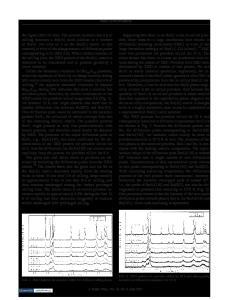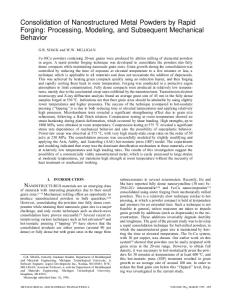Fabrication of Nanostructured Medical-Grade Stainless Steel by Mechanical Alloying and Subsequent Liquid-Phase Sintering
- PDF / 723,452 Bytes
- 5 Pages / 593.972 x 792 pts Page_size
- 19 Downloads / 334 Views
ODUCTION
TO meet the best mechanical and corrosion behaviors of powder metallurgy parts, it is well established that high densities are imperative. To do so, several approaches like applying warm compaction, increasing sintering temperature and time, and using proper additives to activate liquid-phase sintering are considered. In the liquid-phase sintering process, the formation of a liquid phase promotes densification via providing a particle rearrangement, faster diffusion rate, and pore elimination,[1,2] opening up the further commercial development of powder metallurgy parts. Concerning powder metallurgy of stainless steels, because high solidstate sintering temperatures generally more than 1573 K (1300 °C) are required to obtain a high density,[3,4] their liquid-phase sintering process lowering sintering temperature and time is a promising field from scientific and technological viewpoints. To activate liquid-phase sintering of these alloys, various additives like Cu, Sn, Ni, Pt, Ag, Si, Au, B, and P, as well as their compounds and alloys, have been investigated.[1,2] Austenitic stainless steels, typically AISI 316L, are conventionally used in medical applications; nevertheless, ERFAN SALAHINEJAD, Ph.D. Student, MOHAMMAD J. HADIANFARD, Professor, and SHIRAZEH BAGHERI MASHHADI, Researcher, are with the Department of Materials Science and Engineering, School of Engineering, Shiraz University, 7134851154, Shiraz, Iran. Contact e-mail: erfan.salahinejad@ gmail.com MOHAMMAD GHAFFARI, Research Assistant, is with the Department of Electrical and Electronics Engineering, UNAM-National Institute of Materials Science and Nanotechnology, Bilkent University, Ankara 06800, Turkey, and with the School of Electrical and Electronic Engineering, Micro Electronic Division, Nanyang Technological University, Singapore 639798, Singapore. ALI K. OKYAY, Assistant Professor, is with the Department of Electrical and Electronics Engineering, UNAM-National Institute of Materials Science and Nanotechnology, Bilkent University. Manuscript submitted January 4, 2012. Article published online May 10, 2012 2994—VOLUME 43A, AUGUST 2012
the harmful effects of nickel ions released from this type of implants have provided a high level of motivation for the further development of nickel-free alloys.[5] In the ASTM standards, two nickel-free, medical-grade stainless steels have been imported: ASTM F2229 (nominated as Biodur 108) and ASTM F2581 (nominated as P558). In the recent years, in vitro and in vivo studies have been conducted on the latter having the nominal composition of Fe–17Cr–10Mn–3Mo–0.4Si–0.5N–0.2C from the viewpoints of biocompatibility, osseointegration, and corrosion behaviors.[6–11] It is well established that mechanical alloying (MA) can develop a wide variety of equilibrium and nonequilibrium structures including nanostructured and amorphous powders.[12] In this work, mechanically alloyed P558 stainless steel powder is liquid-phase sintered with a biocompatible sintering aid (Mn–11.5 wt pct Si) and then the resultant microstructure i
Data Loading...











